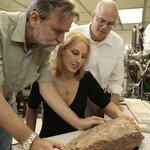Geology

As ice melts away from Antarctica, parts of the continental bedrock are rising in response -- and other parts are sinking, scientists have discovered, and the finding will give much needed perspective to satellite instruments that measure ice loss on the continent, and help improve estimates of future sea level rise.
"Our preliminary results show that we can dramatically improve our estimates of whether Antarctica is gaining or losing ice," said Terry Wilson, associate professor of earth sciences at Ohio State University. Wilson reported the research in a press conference Monday,…

A detailed analysis of the measurements of five different satellites has revealed the existence of the warm plasma cloak, a new region of the magnetosphere, which is the invisible shield of magnetic fields and electrically charged particles that surround and protect Earth from the onslaught of the solar wind.
The study was conducted by a team of scientists headed by Charles "Rick" Chappell, research professor of physics and director of the Dyer Observatory at Vanderbilt University and published this fall in the space physics section of the Journal of Geophysical Research. The northern…

One of the moons in our solar system that scientists think has the potential to harbor life may have a far more dynamic ocean than previously thought. If Europa is tilted on its axis even slightly as it orbits the giant planet Jupiter, then Jupiter's gravitational pull could be creating powerful waves in Europa's ocean, according to Robert Tyler, an oceanographer with the University of Washington's Applied Physics Laboratory and author of a letter on the subject in the Dec. 11 Nature. As those waves dissipate, they would give off significant heat energy.
Depending on the amount…

A new picture of the early Earth is emerging, including the surprising finding that plate tectonics may have started more than 4 billion years ago — much earlier than scientists had believed, according to new research by UCLA geochemists.
"We are proposing that there was plate-tectonic activity in the first 500 million years of Earth's history," said geochemistry professor Mark Harrison, director of UCLA's Institute of Geophysics and Planetary Physics and co-author of the Nature paper. "We are reporting the first evidence of this phenomenon."
"Unlike the longstanding myth of a…

Saturn's moon Enceladus may indeed hide an underground reservoir of water.
Scientists at Jet Propulsion Lab in California, the University of Colorado and the University of Central Florida in Orlando teamed up to analyze the plumes of water vapor and ice particles spewing from the moon. They used data collected by the Cassini spacecraft's Ultraviolet Imaging Spectrograph (UVIS). Cassini was launched from the Kennedy Space Center in 1997 and has been orbiting Saturn since July 2004.
The team, including UCF Assistant Professor Joshua Colwell, found that the source of plumes may be vents on…

Evolution isn't just for living organisms. Scientists at the Carnegie Institution have found that the mineral kingdom co-evolved with life, and that up to two thirds of the more than 4,000 known types of minerals on Earth can be directly or indirectly linked to biological activity. The finding, published in American Mineralogist*, could aid scientists in the search for life on other planets.
Robert Hazen and Dominic Papineau of the Carnegie Institution's Geophysical Laboratory, with six colleagues, reviewed the physical, chemical, and biological processes that gradually transformed about a…

In the Arctic in spring, the snow cover gives off nitrogen oxides. This phenomenon, the extent of which had not been previously realized, is the source of one third of the nitrates present in the Arctic atmosphere, according to researchers from CNRS, the Université Joseph Fourier and the Université Pierre et Marie Curie[1]. They made a quantitative study of the origin and evolution of nitrogen compounds in the Arctic atmosphere, in order to understand their environmental impact on this region. These findings are published in the 31 October 2008 issue of the journal Science.
In the Arctic, the…

A quarter-million people were killed when a tsunami inundated Indian Ocean coastlines the day after Christmas in 2004. Now scientists have found evidence that the event was not a first-time occurrence.
A team working on Phra Thong, a barrier island along the hard-hit west coast of Thailand, unearthed evidence of at least three previous major tsunamis in the preceding 2,800 years, the most recent from about 550 to 700 years ago. That team, led by Kruawun Jankaew of Chulalongkorn University in Thailand, included Brian Atwater, a University of Washington affiliate professor of Earth and space…

NASA's Mars Reconnaissance Orbiter has observed a new category of minerals spread across large regions of Mars. This discovery suggests that liquid water remained on the planet's surface a billion years later than scientists believed, and it played an important role in shaping the planet's surface and possibly hosting life.
Researchers examining data from the orbiter's Compact Reconnaissance Imaging Spectrometer for Mars have found evidence of hydrated silica, commonly known as opal. The hydrated, or water-containing, mineral deposits are telltale signs of where and when water was…

For the second time this year, The University of Western Ontario Meteor Group has captured incredibly rare video footage of a meteor falling to Earth. The team of astronomers suspects the fireball dropped meteorites in a region north of Guelph, Ontario, Canada, that may total as much as a few hundred grams in mass.
The Physics and Astronomy Department at Western has a network of all-sky cameras in southern Ontario that scan the sky monitoring for meteors.
On Wednesday, October 15 at 5:28 a.m., all seven cameras of Western's Southern Ontario Meteor Network recorded a bright, slow…